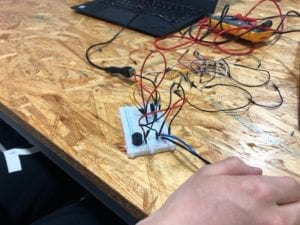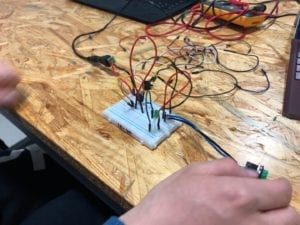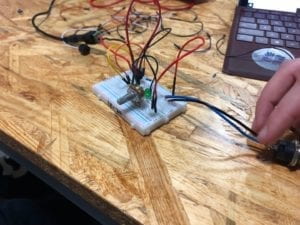Upon taking this class, I knew little about building circuits, interactivities, even using the computer. Week 1 recitation was a bridging experience for me, and also gave me the nostalgia of middle school physic classes. Before working on the first circuits, I was terrified and didn’t know yet what I was going to do. Luckily, I was assigned a partner, Tom Zhu, who was willing to bear my ignorance and walk me through the first exercise. Shout out to Tom!
(1) Door Bell

Components:
1*Breadboard: a baseboard for building circuits
1*Buzzer: makes sounds while there’s the right electric flow
1*100 nF Capacitor: stores electric charge as designed.
1*Switch: circuit changer; connect or block the electricity in the electric circuit.
1*LM7805 Voltage regulator: change the voltage level
1*12volt power supply: 12volt power provider for our circuit.
Several jumper cables: connect different components in the circuit.
1*Barrel jack: connect the power supply and the circuit.
(2) Lamp

Additional Components:
1*LED: makes light with the electric flow.
1*220ohm Resistor: the resistance to electricity flow.
(3) Dimmable Lamp

Additional Components:
1*10K ohm Variable Resistor: it provides variable resistance to block the electricity flow. In this case, the change in electricity flow would vary the degree of lightness of the LED.
Debriefing of the building process:
I was confused and didn’t know how to start with the components, so my partner Tom has shown me the process of building circuit 1. I disembled the circuits he built and rebuilt it under his instructions.
After gaining the basic knowledge, my partner trusted me and asked me to build 2, and 3 by myself. With his instructions and help, circuit 2 was built perfectly and went through the testing for its first time.
I have bumped into some problems with circuit 3 – the led didn’t blink as expected. Going into examining, Tom and I found that the led with connected in the opposite direction. After altering it, it worked. In general, the whole process was not that difficult, but for me, it took courage and patience to start the whole learning process. Thanks to Tom, the recitation ended with a happy ending.
Question 1:
In the article, the author defined interactivity as “a cyclic process in which two actors alternately listen, think, and speak”. In fact, I would like to extend the definition to a cyclic process involving at least 2 actors with in possible forms of senses. If we look at the recitation this week, we are able to track every detail of interactivity definition. Building circuit 1, 2, and 3 involves the exchange from touching sense to sound and visual sense. In the meantime, I would argue the process of cooperating in building circuits as a group itself is a form of interactivity between two members as well as the components. In Buddism, the sutras argue that all form of existence and reality is built on the interaction involving at least two actors.
Question 2:
If we limit the definition of interactivity to a more practical standpoint, I would argue the Interaction Design and Physical Computing can actually extend the human capacity to interact with each other. Linking to the video, we can find multiple examples that Interaction Design and Physical Computing extend the human capacity in translating our senses of touch, sight and hearing into a higher form of presentation. In the meantime, we shall not limit ourselves into binding ourselves the forms of Interaction Design and Physical Computing we can do with art-making. Although we now highly rely on the sense of touch in building and sense of hearing and sight in receiving. Stuff like Siri and Alexa already proved us that speaking as a form of input is already a growing reality, so are other forms of human senses. Going back to question 1, I would argue that Interaction Design and Physical Computing is a developing tool of human beings in extending and linking all different forms human senses, and art-making, no doubt, is an important part of it.